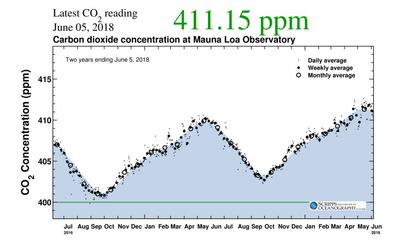Two years of CO2 measurements at the Mauna Loa Observatory, showing how seasonal highs and lows are steadily rising. Scripps Institution of Oceanography
Levels of carbon dioxide in the atmosphere exceeded 411 parts per million (ppm) in May, the highest monthly average ever recorded at the Mauna Loa Observatory in Hawaii, home to the world’s longest continuous CO2 record. In addition, scientists found that the rate of CO2 increase is accelerating, from an average 1.6 ppm per year in the 1980s and 1.5 ppm per year in the 1990s to 2.2 ppm per year during the last decade.
“Many of us had hoped to see the rise of CO2 slowing by now, but sadly that isn’t the case,” said Ralph Keeling, director of the University of California San Diego’s Scripps CO2 Program, which maintains the Mauna Loa record with the National Oceanic and Atmospheric Administration. “It could still happen in the next decade or so if renewables replace enough fossil fuels.”
Annual CO2 concentrations ebb and flow depending on the season. The lowest levels are generally recorded in late August or early September, when vegetation growth in the Northern Hemisphere is at its peak. The highest concentrations are generally measured in May, following winter months with little or no plant growth and just before the springtime boost in productivity.
From 2016 to 2017, the global CO2 average increased by 2.3 ppm — the sixth consecutive year-over-year increase greater than 2 ppm, according to Scripps researchers. Prior to 2012, back-to-back increases of 2 ppm or greater had occurred only twice.
“CO2 levels are continuing to grow at an all-time record rate because emissions from coal, oil, and natural gas are also at record high levels,” Pieter Tans, lead scientist of NOAA’s Global Greenhouse Gas Reference Network, said in a statement. “Today’s emissions will still be trapping heat in the atmosphere thousands of years from now.”
For more background on how the world crossed a carbon threshold and why it matters, click here.



